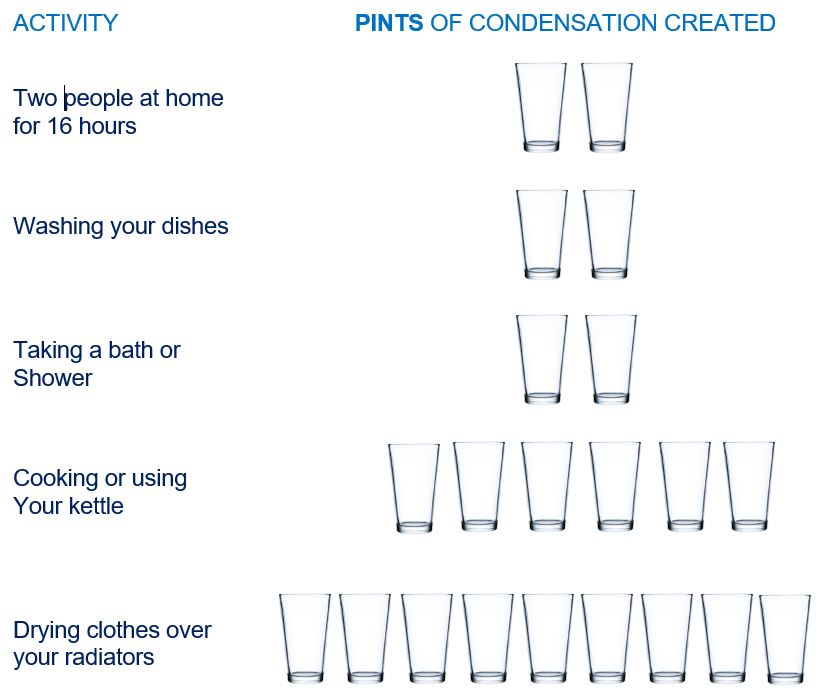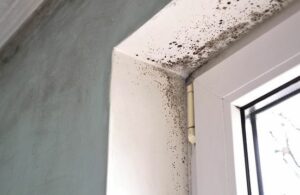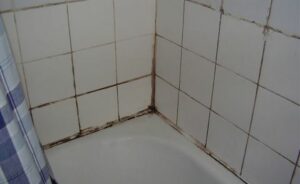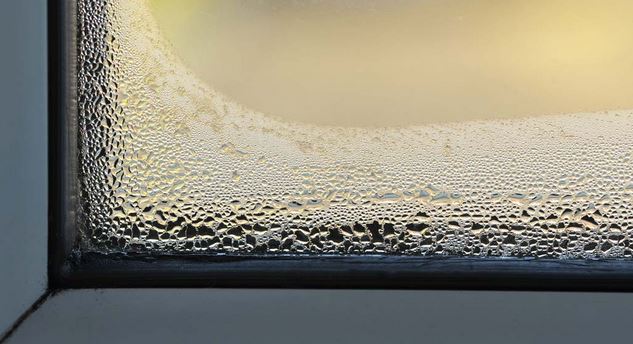Information on condensation and how to prevent it.
What is condensation?
When moist air comes into contact with a cool surface water droplets form. This is the same effect as when you breathe on a mirror. On a window, the glass mists up and drops of water trickle down. On a wall, the wall soaks up the moisture and becomes damp. Mould then tends to grow on the damp areas.
Where does the moist air come from?
We all give off water from our bodies all the time, when we breathe and from our skin. We also put lots of water into the air when we use a tumble drier, when we air or dry clothes indoors, take a bath or shower, and even when we cook, or wash the dishes. Bottled gas heaters produce large amounts of water vapour. Moist air can travel through our homes and cause condensation if it comes into contact with a cool surface like a window or an outside wall.

Why is it only in certain areas?
Condensation tends to occur on outer walls, which are cooler. It often shows as a dark patch next to the ceiling, or next to the skirting, and especially in corners. External walls with windows are often affected, as they can be even colder.
Areas which have poor ventilation can be very prone to condensation. This might be behind and inside cupboards, dressers and wardrobes, or behind the bed if this is against an outside wall. All our windows are fitted with ‘trickle vents’ and these should be open.
It can happen in any room, but tends to be more of a problem in bedrooms and stairwells, as these are cooler. Bathrooms have the most condensation of all – especially on tiles. Wiping the tiles down and airing the bathroom after showers or baths can help. Continued build-up of condensation may lead to mould growth. All our bathrooms are fitted with extractor fans and these should always be used. You should never turn off the ‘override’ switch so that the fan doesn’t run.
Why does mould grow and is it harmful?
Mould is formed from general household dust. It normally causes no harm because the intensity in the air is very low. If it lands on a cool damp area of wall the mould will start to grow. After a while the mould becomes visible as a dark coloured patch. This is often black, but can be other colours.
At that stage the mould begins to release millions of new spores into the air inside your house. These new spores can very quickly spread the mould to other areas of the house. If they get into clothes then you will notice a fusty smell. On some rare occasions prolonged exposure to mould may aggravate existing conditions including asthma so it is very important to deal with mould patches as soon as possible.

What can I do, and where do I start?
Rooms like those mentioned earlier need more precautions than normal to stop condensation forming due to humidity levels – but the things you can do are quite basic and easy.
If you have mould growing, then deal with that first. It is usually quite easy to kill and there is no need to scrub, or to use strong chemicals. Wash and treat the affected area with mould remover that is available FREE OF CHARGE from the WGHC office. It is normal for staining to remain after this process so don’t be alarmed if staining remains. If, after that, you are concerned and believe there is a bigger underlying problem, please get in touch with the office and we can attend and undertake a full damp, mould and condensation assessment, using some bespoke software and monitoring equipment.
After dealing with any mould you can deal with the condensation.
The traditional answer of turning up the heating to dry up the damp, and opening the windows to blow the moist air out can work, however uses huge amounts of energy and can be very expensive.
Nowadays, we suggest a range of measures that work together to cure the problem and we suggest starting with the cheapest and easiest solutions first:-
- Think about where you produce moisture into the air, and try to reduce it. For example, if you use a tumble drier in the house, use a vent ducting kit to take the wet air outside, or a self-condensing attachment.
- Cook with lids on pans.
- Sometimes we can’t help making lots of moisture in the air – cooking, taking a shower, airing/drying clothes etc. Stop the water spreading to other parts of the house by shutting the door and opening a window in the room to let the wet air escape.
- If you have an extractor fan in a wet area use it every time you bathe or shower
- Mould spores hate fresh air, so it is vital to keep damp rooms well aired. Ventilating the full property to improve air circulation and prevent condensation build up is a must. It is even more important than keeping it heated. If you have double-glazing, keep the air vent above the window open all the time. Try to have the window open a little for an hour every morning when you get up. On fine days open the window wider, if you can do so safely.
- Bedding, clothing and other textiles stored in drawers and wardrobes can hold cold air and become fusty quite quickly due to poor ventilation. Leave wardrobe doors open to let fresh air in. If a room is particularly damp, then you might want to keep clothes stored in a different room.
- Any damp areas that are also poorly ventilated will tend to allow mould to grow. This often happens behind wardrobes and cupboards, and at the side of the bed. Try to have a gap behind and around furniture to allow air to circulate. Try not to put furniture against a cold outside wall.
- Try not to let the room get chilled. There is no need to keep the room particularly warm, however a little steady heat is better at keeping the humidity levels steady. If you can only have the heating on for short periods, then early evening and early morning are the best times.
- Reduce the amount of household items and textiles (e.g. Clothing, Bed Linen etc.) stored within rooms and prevent clutter which could trap moist air and lead to mould growth.

How can WGHC Help You?
If you continue to experience problems relating to condensation and mould growth you should report this to either the Housing Management or Mainteance Team immediately. We may take the following actions depending on the circumstances;
- Carry out a Property Inspection to determine any actions required
- Provide expert guidance on condensation and how this can be managed
- Review of existing ventilation within the property and the potential installation of extractor fans in kitchen and bathroom or whole house ventilation systems dependant on property needs
- Help you to find the right advice on heating, ventilation, and condensation as well as energy efficiency measures including loft and cavity wall insulation through an energy advice referral.
- Surveying of existing radiator sizes to ensure these are sufficient for the room size.
- In certain situations we may assist you with a top up to your gas so you are less likely to worry about using your central heating
Advice on decoration and treatment
As black spot mould is a surface mould the following steps will be required in certain circumstances to treat and re decorate the affected area:-
- Affected area will need to be stripped back to the plaster/painted surface e.g. the removal of wallpaper
- Mould growth should be washed down with mould remover spray that is available FREE OF CHARGE from the WGHC office. This should be done every day over a 5 day period. It is normal for staining to remain after this process so don’t be alarmed if staining remains.
- Affected area should be sealed with anti-fungal paint, or oil based paint i.e. kitchen or bathroom type to seal any staining.
- Wall should then be re decorated as normal.

More Information
To see a copy of the WGHC Policy, click on the following “Management of Damp, Mould & Condensation Policy & Procedure”
More detailed information can be found in a Scottish Government Keep your home free from damp and mould leaflet. In some cases you may be able to get a grant towards the cost of some of the measures. More information is available at the Change Works website.
Please don’t accept living with damp, mould or condensation – get in touch with the office, 0131 551 5035 or email: info@westgrantonhc.co.uk
